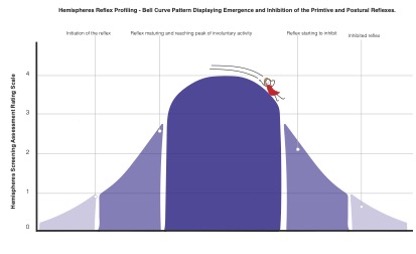Articles
The Primitive and Postural Reflexes as defined by Hemispheres

There is a recognised typical pattern of emergence and inhibition of the reflexes. However, from my own clinical practice, it appears evident that the reflexes can persist into later ages and into adulthood, even amongst well-functioning children and adults.
Data on the prevalence of the reflexes beyond their expected date of inhibition is not available yet. Amongst the population of children who seek help from Hemispheres, we are gathering a growing body of evidence to support the presence of specific reflexes that correlate with a defined set of symptoms, thus indicating a possible predictive nature to the impact these reflexes have on skill development and behaviours. Equally we are finding that specific diagnostic groups display definite reflex profiles. However, these groupings need to be further researched, explored and ratified to show true credibility as a diagnostic or predictive measure.
At present, Hemispheres views the reflexes as being grouped in terms of their functional, emotional, physical, neurological and behavioural effects/components. Equally, they can be thus grouped as levels for intervention during treatment. These groupings are effective, therefore, in both assessment and treatment and can help to define and clarify a practitioner’s clinical reasoning and intervention when working with a child.
The reflexes listed below are not the only reflexes within a child’s system, but they do represent a clear and defined cohort of reflexes that show a profile of neurological development/immaturity. A good place to start.
The following descriptions define each reflex group and briefly explain the impact they can wield on the reflex chain as a whole:
The Grasping Reflexes
This group is comprised of the Palmar, Plantar, Babinski, Sucking and Rooting Reflexes. These reflexes are all expected to be active at birth. They work together to assist the baby to settle and facilitate early arousal of the cortex. Initially they link together and then separate the Babkin Response (hands, mouth and feet connectivity). The baby develops feelings of security, thereby settling the Moro Reflex, whilst gaining adequate comfort and nutrition from the parent through the establishment of feeding routines.
The first section of the Hemispheres Neurological Assessment assesses the presence of each of these reflexes and observes the interplay between them. Experience has shown that involuntary activity in any of these reflexes can disrupt the emergence and integration of later reflexes. This can negatively influence the functional skills which are associated with reflexes higher up the reflex chain.
The Emotional Based Reflexes
This group is comprised of the Fear Paralysis Response and the Moro or Startle Reflex. These reflexes are significant in establishing the child’s ability to interpret sensory information from their own body and the environment around them. This facilitates feelings of security, attachment and emotional expression. These reflexes are VERY SENSITIVE. They have the potential to upset the whole chain of reflexes and need to be treated with respect, sensitivity and consideration. It is for this reason that these reflexes are assessed at the end of the Hemispheres Neurological Assessment (HNA). This ensures as much early compliance from the child as possible.
Integrating Reflexes
This group is comprised of the Tonic Labyrinthine Reflex (TLR), Asymmetrical Tonic Neck Reflex (ATNR) and the Symmetrical Tonic Neck Reflex (STNR). The interactions of these three reflexes are key in establishing sensory awareness of the Sagittal (left and right), Transverse (top and bottom) and Frontal (front to back) midlines of the body. They thereby facilitate the child’s developmental of movement against gravity. Being able to isolate and control the body in each and between all three of these midlines is essential for accurate motor planning, sensory awareness of the body’s position and efficient proprioceptive and vestibular functioning for balance, climbing and interacting with objects. This set of reflexes is paramount in establishing connectivity within the brain itself, and between the brain and the body for learning and whole-body coordination respectively.
Facilitating Reflex
There is a clear pattern of interaction between the reflexes which have proximity within the reflex chain. However, the Spinal Gallant Reflex is one which not only facilitates the integration of the reflexes but is also active and present during the actual birthing process. This reflex, therefore, crosses many boundaries and is important for the settling of the grasping reflexes.
Lifelong Reflexes
This group is comprised of the Head Righting, Amphibian and the Vestibular Reflexes. These reflexes are stimulated through the movement of the child in the early stages of sensory and motor development. They therefore facilitate the inhibition of the other reflexes, especially the integrating reflexes on their journey of establishing appropriate and efficient control of the body against gravity. These reflexes remain for life. Hence, the aim of any intervention is not to inhibit these reflexes, but to establish efficient automatic control for balance and other equilibrium reactions. Another lifelong reflex is the Moro, which when matured acts to support our fight and flight responses.
Dont forget to read the next article on the pattern of reflex development.
You might also be interested in

The Hemispheres Conceptual Model - Underpins our way of working.

Hemispheres Pyramid of Development and Learning

The Pattern of Reflex Development
Copyright © 2026 | Privacy Policy


